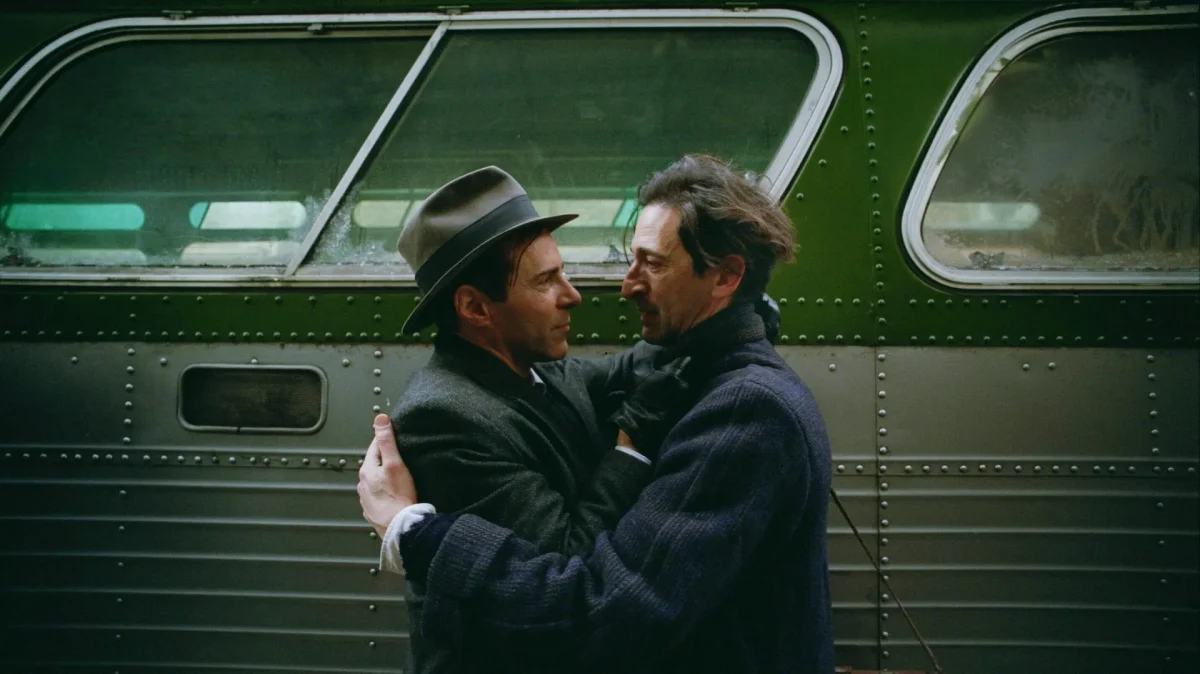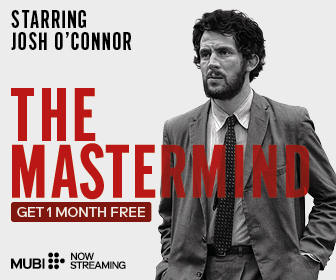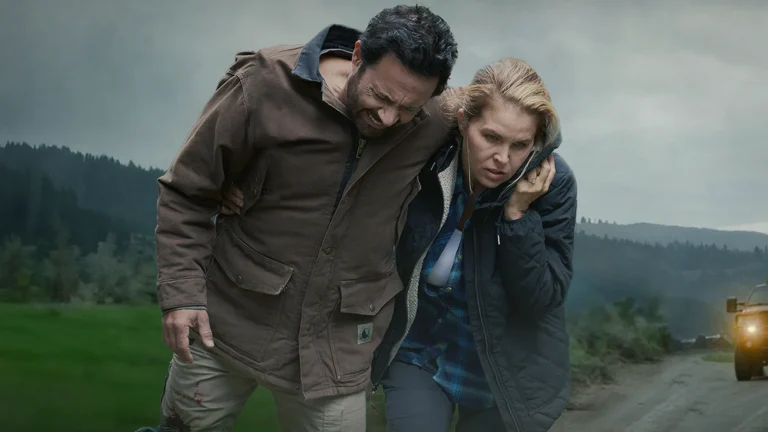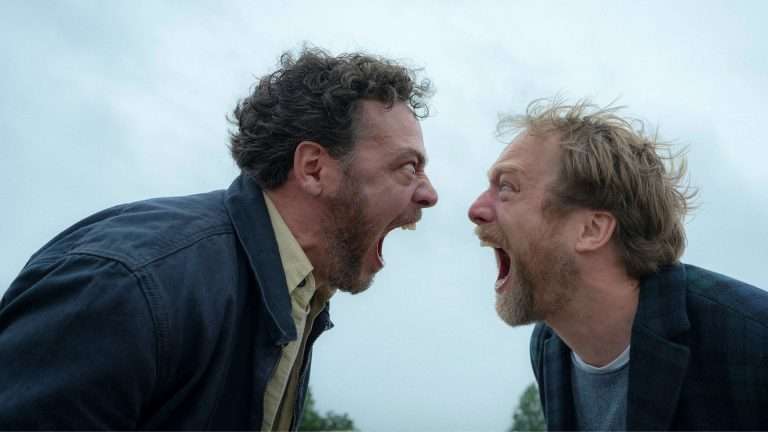Like the architectural wonders its protagonist creates, “The Brutalist” looks very different depending on the viewing angle. Some critics label it Zionist propaganda, while others denounce it as antisemitic. However, neither viewpoint grasps the political allegory at the heart of Corbet’s epic, which addresses the frailty of contemporary notions of freedom, the roots and horrors of personal and national quests for immortality, and conversely, the secular salvation that may be found in settling for a walk-on role in eternity.
The film opens as architect László Tóth flees the horrors of the Buchenwald Concentration Camp and emigrates to the US in search of freedom. But when our first glimpse of the New World is an inverted shot of the Statue of Liberty, it becomes clear that he is merely destined for a new brand of imprisonment. To hammer the point home, the sequence is voiced over by László’s wife, Erzsébet, who remains in Europe under the watch of Russian guards. Her letter concludes with a quote by Goethe: “None are more hopelessly enslaved than those who falsely believe themselves free!”
And it is in the proverbial land of the free that László learns success can be achieved only by adhering to strict codes. His cousin runs a successful business, but has shed his accent and changed his surname. László is offered an illustrious job but must endure all manner of exploitation by his employer to keep it.
The new world is an intolerant one, and survival requires acts of self-effacement, a removal of surface detail that mirrors the sheer concrete facades of László’s buildings. It would be naive to assume that Corbet’s film is talking about the booming postwar past. The present neoliberal US, with its commitment to shredding social guarantees, is a far more prudent social architect, shearing away those who cannot fend for themselves, who cannot meet a narrow definition of utility.
Also Read: The Brutalist (2024) Movie Review: Brady Corbet and the Odyssey of a Visionary Foreigner
Nor is this self-effacement confined to the aesthetic. “The Brutalist” is fundamentally concerned with the return of the repressed. The tortures its protagonist suffers during the Holocaust are condensed into less than a minute of screentime – a dreamlike sequence with no fixed spatial or temporal logic, simply mud, dark, and fear. But contrary to the laws of physics, which Tóth has mastered, in psychology, what goes down must come back up. The imperturbable rise of the protagonist’s trauma is evident in his heroin addiction, his abuse and betrayal of his wife, and ultimately, in the dark heart of the monument he constructs.
As László’s building – the Van Buren Institute – grows, it is mirrored by the recently established State of Israel, the formation of which is a subplot that mirrors the main storyline. Both are constructions of Holocaust refugees. Both have utopian ambitions and religion at their cores – the cast of a cross, hollowed from the Van Buren Institute’s stone roof, begs the question as to whether its symbolic values are present or shorn away (perhaps a hint can be found in László Toth’s name, which is shared with a Australian-Hungarian geologist who attacked Michelangelo’s Pietà with a hammer in 1972, breaking off Mary’s arm and damaging her face).

Both László’s monument and the 1948 foundation of the State of Israel are ideas sparked by traumatic persecution, with dire consequences for those in the periphery. Tortured by the Holocaust, the architect suffers night terrors and self-medicates with heroin during the day. Having come close to annihilation, he grasps at its opposite: immortality.
When Van Buren questions him about the motives behind his architecture, László responds, “There was a war on. And yet it is my understanding that many of the sites of my projects have survived. […] When the terrible recollections of what happened in Europe cease to humiliate us, I expect for them to serve instead as a political stimulus, sparking the upheavals that so frequently occur in the cycles of peoplehood”.
Must Check Out: 8 Movies to Watch If You Like ‘The Brutalist’
László’s words indicate not just a fixation with his legacy, but the belief that his buildings will somehow wreak revenge for the Holocaust through the “upheavals” they might inspire. His constructions are both an imagined undoing of the horrors of persecution and an escape from the fragility of existence to which they awakened him. When Zsófia tells her aunt and uncle that migrating to Jerusalem is an ‘obligation’, and that ‘Our repatriation is our liberation’, it becomes clear that she is operating under similar motives.
But László’s repression and quest for immortality come at a huge cost to all who surround him, nearly destroying him in the final act. These tolls are symbolized by the dark, soiled heart of his monument, which ultimately becomes a tomb. This torrid edifice serves as a stern warning against utopian projects that would repress the lives and livelihoods of others.
When, in the epilogue, Zsófia attends a celebration of her uncle’s life’s work and proclaims to a crowded room that ‘It’s not the journey, it’s the destination’, everything we have seen – including the now withered and wheelchair-using László – tells us not to believe her. Bury the journey and it will come back to haunt you.
If quests for immortality and the utopian impulse are to be distrusted, then in what can we have faith? “The Brutalist” delivers an answer at the beginning of its 1980 epilogue, directly after the Van Buren Centre’s rotten core is exposed, and moments before Zsófia’s celebratory speech. In this sequence, light dance music plays over a montage of Venice, a city that will one day be lost to the tides.
The montage features winding canals, rickety piers, lively streetscapes, and classical statues with corroded faces – become anonymous with time. Unlike László’s sheer edifices, all are rich in detail and brim with a life born of decay. Immortality is forfeited for their architects, but they bear a greater signature – that of time, and the elements, and of life across millennia.







![Extraction [2020] Netflix Review: An effort that is mediocre at best](https://79468c92.delivery.rocketcdn.me/wp-content/uploads/2020/04/Extraction-cover-1-768x384.jpg)
